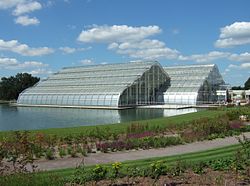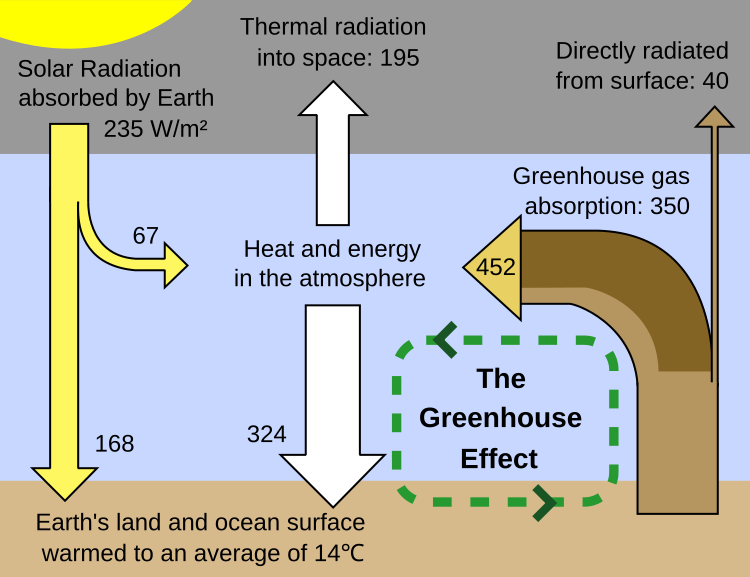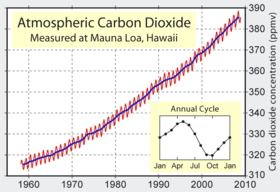As an assIgnment for the last twenty-two days, we have kept a daily weather record documenting high and low temperatures, barometric pressure, wind speed and direction, relative sky cover, and precipitation types and amounts. By recording this daily data, we can observe patterns in our local weather and compare them with those previously recorded. With Michigan weather, it seems that an in-depth analysis of this not-so-perfectly collected information would reveal little more than inconsistent day-to-day fluctuations, and any thoughtful attempt to find a reasonably solid correlation between the given variables (beyond the obvious ones like "on the days the precipitation type is 'not applicable,' it appears the amount is always 0...") would ultimately prove futile.
How does this connect to my topic? One might say that the weather conditions in Michigan are, in fact, affected in no small part by the Greenhouse Effect. However a legitimate and extensive connection between the two topics is currently beyond my immediate capability and attention span, so a brief allusion to its importance must make do. However, if you will accept a generalization in this matter, the gradual increase in temperature from beginning to mid-spring is assisted in part by the thermal insulation provided by the atmosphere, in accordance to the Greenhouse effect. It would not be nearly as warm here this day if the Greenhouse Effect was, for some strange reason, not in effect. That's pretty much all I have to say in that matter; and it's more than enough.
Relevant weblinks:
http://www.nws.noaa.gov/os/reachout/kidspage.shtml
http://www.weathermichigan.com/miwxcams.htm
Irrelevant weblinks:
http://www.defenders.org/wildlife_and_habitat/wildlife/grizzly_bear.php
http://www.cotf.edu/ete/modules/msese/earthsysflr/rock.html
The Greenhouse Effect
The Greenhouse Effect is a natural phenomenon that dramatically influences climate patterns on a global scale. It is named for the concept of a literal greenhouse- sunlight entering through glass, reflecting off of the inside, and reflecting off the glass again. The very same concept applies in other situations as well. For example, a car which is parked in the sun with its windows closed heats up similarly for the same reason. This concept also occurs on the global level- the atmosphere blankets the Earth by trapping infrared radiation- and this global condition is an accurate definition of the Greenhouse Effect.

http://en.wikipedia.org/wiki/Image:RHSGlasshouse.JPG
What causes the Greenhouse Effect in the Earth's atmosphere is the accumulation of "greenhouse gases" that reflect solar radiation back to Earth. Some of the primary greenhouse gases on Earth include water vapor, carbon dioxide, methane, and carbon monoxide. These gases allow most solar radiation to pass through to the surface of the planet. Much of the radiation of shorter wavelengths is absorbed then by the ground or ocean, while the longer-wavelength energy- particularly infrared waves- are not absorbed and therefore reflects back into the atmosphere. This thermal energy, if not for the atmosphere, would escape into the vacuum of space. However, due to the presence of these various greenhouse gases, much of the radiation does not escape. It is instead absorbed by the greenhouse gas compounds, where its precious heat can be returned to the Earth. The extra heat provided by the Greenhouse Effect is critical to the balance of the global climate and if the atmosphere were somehow magically removed, the importance of its influence would become almost immediately evident. The Earth's current average surface temperature with the Greenhouse Effect in action is 14 degrees Celsius. According to estimations, if the Earth did not have an atmosphere, its surface temperature would drop a whopping 33 degrees to -19 Celsius! (http://en.wikipedia.org/wiki/Greenhouse_effect#cite_note-1)

http://en.wikipedia.org/wiki/Image:Greenhouse_Effect.svg
It is certainly very clear how vital the Greenhouse Effect is to maintaining the current life system on Earth- without it the global ecosystem would cease to function as it does, and mass extinction would occur. However, the Greenhouse Effect can work in a more adverse direction as well. Since the dawn of the Industrial Age, it has proven itself, in fact, to be one of the prominent culprits behind the recent trend of global warming.
(http://lwf.ncdc.noaa.gov/oa/climate/gases.html#cf) This is because industrialization has given rise to a new reinforcement to the global blanket of greenhouse gases- manmade chemicals. The constant churning of human industry has brought new synthetic products into the atmosphere that have similar effects to those of other natural gases. Some of these include chlorofluorocarbons (CFCs) found in aerosol propellants and cleaning solutions, as well as
synthesized carbontetrafluoride and sulfurhexafluoride. In addition, excess carbon dioxide is another major concern- its accumulation catalyzed by human combustion used for energy generated from fossil fuels and in vehicular exhaust.

http://en.wikipedia.org/wiki/Image:Atmospheric_Transmission.png
How are the effects of the Greenhouse Effect predicted? Well, it's a combination of scientific study, careful calculation, and most of all constant data collection. By taking the composition of the atmosphere and comparing it to trends in global climate, scientific researchers can determine the degree of effect that human influence has on the global environment through its magnification of the Greenhouse Effect. By conducting ongoing and extensive research, we can observe the extent of the effect it has. In observing these trends, we can also project the course that will be taken in the concentration of greenhouse gases in the near future, and therefore foresee the effects that the continuation of our current course will have.

http://en.wikipedia.org/wiki/Image:Mauna_Loa_Carbon_Dioxide.png
How are warnings about the adverse conditions brought on by an increase of greenhouse gases issued? Well, that is simply a question of publicity, media coverage, and the instruction of the ignorant public. There's been a considerable hype over the issue of global warming in recent years, and some of the primary media targets have been television advertisement and the internet. The organizations putting out the informative material are trying to emphasize the seriousness, the reality of the issues surrounding the consequences of global warming. By helping the public come to understand the problem and its causes, and show the measures that must be taken to prevent it, a possible solution to the upcoming issue is also initiated.

http://en.wikipedia.org/wiki/Image:Instrumental_Temperature_Record.png
Links to Factual Information:
http://lwf.ncdc.noaa.gov/oa/climate/gases.html
http://earthguide.ucsd.edu/earthguide/diagrams/greenhouse/
http://hyperphysics.phy-astr.gsu.edu/hbase/thermo/grnhse.html
http://epa.gov/climatechange/kids/greenhouse.html
http://en.wikipedia.org/wiki/Greenhouse_gas
http://en.wikipedia.org/wiki/Greenhouse_effect
http://en.wikipedia.org/wiki/Global_Warming
Bibliography:
-(2005, Dec 1). NCDC: Greenhouse Gases. Retrieved April 2008 from National Oceanic and Atmospheric Administration website: http://lwf.ncdc.noaa.gov/oa/climate/gases.html
-(2008, Apr 18). Greenhouse effect. Retrieved April 2008 from Wikipedia: http://en.wikipedia.org/wiki/Greenhouse_effect
-Greenhouse Effect. Retrieved April 2008 from: http://hyperphysics.phy-astr.gsu.edu/hbase/thermo/grnhse.html
Wednesday, April 16, 2008
Tuesday, April 15, 2008
WES Activity D
This activity sought to demonstrate the cause of the Coriolis Effect- the phenomenon that causes winds and water in the Northern Hemisphere to rotate clockwise and those in the Southern Hemisphere to rotate counterclockwise. To demonstrate the effect, a practical model involving two loosely attached index cards was used. To simulate the counterclockwise rotation of the earth on its axis from the perspective of the Northern and Southern hemispheres, one card was moved to the left and right while the student traced a line along the edge of the stationary card. The resulting trajectory was curved, either to the right or left, depending on the way that the moving card rotated. This curved trajectory was a clear explanation of the Coriolis Effect. The role of the Coriolis Effect in global winds and water transportation was then investigated.
The transportation of air and water depends largely upon the Coriolis Effect, and so, subsequently, is the transportation of heat and water vapor. The mechanics and function of the Greenhouse Effect thus are greatly affected by the Coriolis Effect, since the global transportation of energy/radiation and greenhouse gases like water vapor determine which areas of the planet are most affected. Since the global transportation system driven by the Coriolis Effect tends to gather water vapor, air, heat, etc. at the tropics, it can be assumed that it is those areas which are most dramatically influenced by the effects of Greenhouse gas radiation.
Relevant Websites:
http://ww2010.atmos.uiuc.edu/(Gh)/guides/mtr/fw/crls.rxml
http://abyss.uoregon.edu/~js/glossary/coriolis_effect.html
The transportation of air and water depends largely upon the Coriolis Effect, and so, subsequently, is the transportation of heat and water vapor. The mechanics and function of the Greenhouse Effect thus are greatly affected by the Coriolis Effect, since the global transportation of energy/radiation and greenhouse gases like water vapor determine which areas of the planet are most affected. Since the global transportation system driven by the Coriolis Effect tends to gather water vapor, air, heat, etc. at the tropics, it can be assumed that it is those areas which are most dramatically influenced by the effects of Greenhouse gas radiation.
Relevant Websites:
http://ww2010.atmos.uiuc.edu/(Gh)/guides/mtr/fw/crls.rxml
http://abyss.uoregon.edu/~js/glossary/coriolis_effect.html
Thursday, April 3, 2008
Activity 4
While this activity was very similar to the demonstration in Activity 1, its setup and focus are slightly shifted. Instead of focusing on the absorption of light/heat energy, it seeks to demonstrate the rules concerning reflection of light/heat energy. Though the lab was, on the whole, kind of a failure in achieving its purpose, some of the data reflected the rules that were meant to be proven. The basic rule for reflection of energy is pretty much the inferred counterpart of the basic rule for absorption. Lighter substances reflect more energy, while darker substances reflect less.
The experiment is, in essence, a physical model of the greenhouse effect, so it's got a great deal to do with it. The demonstration involved plastic bottles filled with the substances in question that were set beneath a lamp. The lamp obviously represents the sun. The plastic bottles model the earth's atmosphere, and the substance is the ground. What this all means is that the greenhouse effect has more effect on lighter colored ground substances than in areas where the ground is darker.
Websites:
http://zebu.uoregon.edu/1998/es202/l13.html
http://hyperphysics.phy-astr.gsu.edu/hbase/thermo/grnhse.html
The experiment is, in essence, a physical model of the greenhouse effect, so it's got a great deal to do with it. The demonstration involved plastic bottles filled with the substances in question that were set beneath a lamp. The lamp obviously represents the sun. The plastic bottles model the earth's atmosphere, and the substance is the ground. What this all means is that the greenhouse effect has more effect on lighter colored ground substances than in areas where the ground is darker.
Websites:
http://zebu.uoregon.edu/1998/es202/l13.html
http://hyperphysics.phy-astr.gsu.edu/hbase/thermo/grnhse.html
Tuesday, April 1, 2008
Why is Nature Playing "April Fools"?
This year, winter has been colder and longer than usual. Over the last few weeks, there have been several periods of snow and subsequent melting and rain. It seems inconsistent, and, having at last past the vernal equinox, it is supposed to be the beginning nice, warm spring weather. Earlier this morning, it was as warm as 60 degrees Fahrenheit, but it's now 40 and dropping. It's ridiculous to personify nature taking on an American custom, though, so no matter how odd the weather is, it's stupid to say that nature is "playing April fools." Either way, there must be an explanation for the unusual weather we've been having...
One of the primary culprits is a phase of La Nina. La Nina is a phase of especially cold Pacific sea-surface temperatures. These low sea temperatures translate as colder-than-normal weather in the U.S. and North America. These conditions will last most likely for a year or two. Anoter cause for this unpredictable weather is a split in the jet stream that carries cold air from the North Pole. Two jetstreams in constant motion make weather patterns erratic and therefore difficult to forecast.
Websites:
http://www.elnino.noaa.gov/lanina_new_faq.html
http://www.srh.noaa.gov/jetstream//
One of the primary culprits is a phase of La Nina. La Nina is a phase of especially cold Pacific sea-surface temperatures. These low sea temperatures translate as colder-than-normal weather in the U.S. and North America. These conditions will last most likely for a year or two. Anoter cause for this unpredictable weather is a split in the jet stream that carries cold air from the North Pole. Two jetstreams in constant motion make weather patterns erratic and therefore difficult to forecast.
Websites:
http://www.elnino.noaa.gov/lanina_new_faq.html
http://www.srh.noaa.gov/jetstream//
Monday, March 31, 2008
WES Investigation C
From this investigation, I have concluded that moisture avection, the movement of water vapor in the atmosphere, is a critical factor in precipitation. I also learned about dewpoints, which measure the amount of water vapor in the atmosphere. Moisture avection, which is driven by atmospheric convection currents, transports the water vapor in the air, and when a large amount condenses in the air, clouds form. When enough moisture collects in this manner, it falls to the ground as precipitation.
The greenhouse effect can have a very substantial effect on the course that weather takes. More reflected heat affects air temperature, which in turn affects air pressure and the convection cycle of the air. These factors determine weather/precipitation.
Relevant Websites:
http://www.unc.edu/depts/cmse/nature/dewpoint.html
http://ww2010.atmos.uiuc.edu/(Gh)/guides/maps/home.rxml
The greenhouse effect can have a very substantial effect on the course that weather takes. More reflected heat affects air temperature, which in turn affects air pressure and the convection cycle of the air. These factors determine weather/precipitation.
Relevant Websites:
http://www.unc.edu/depts/cmse/nature/dewpoint.html
http://ww2010.atmos.uiuc.edu/(Gh)/guides/maps/home.rxml
Friday, March 28, 2008
Activity 1
Activity 1 was a demonstration of energy absorption by different substances on the earth's surface. The three substances involved- dirt, water, and ice- were placed underneath a heat lamp, with temperature probes in them. The probes recorded the increase in temperature as the substances warmed up, then the lamp was turned off and the temperatures were recorded as the substances cooled. The demonstration revealed that the dark soil heated and cooled much more quickly than the other two, revealing that the process of energy absorption takes place more quickly in dark-colored substances than in light-colored substances.
This concept is significantly relevant to the process of the Greenhouse effect. The Greenhouse effect is th process in which "Greenhouse gases" in the atmosphere insulate heat reflected by the earth's surface by reflecting them back toward the ground. The amount that the Greenhouse effect affects a region of the earth depends largely on the ground in that area, as this demonstration showed. Areas with lighter-colored ground reflect more of the sun's radiation, so the amount of harmful radiation (UV rays) reflected is greater in these areas.
Here are some websites pertaining to the activity:
http://www.newton.dep.anl.gov/askasci/gen99/gen99540.htm
http://www.colormatters.com/science_faq.html
This concept is significantly relevant to the process of the Greenhouse effect. The Greenhouse effect is th process in which "Greenhouse gases" in the atmosphere insulate heat reflected by the earth's surface by reflecting them back toward the ground. The amount that the Greenhouse effect affects a region of the earth depends largely on the ground in that area, as this demonstration showed. Areas with lighter-colored ground reflect more of the sun's radiation, so the amount of harmful radiation (UV rays) reflected is greater in these areas.
Here are some websites pertaining to the activity:
http://www.newton.dep.anl.gov/askasci/gen99/gen99540.htm
http://www.colormatters.com/science_faq.html
Subscribe to:
Posts (Atom)